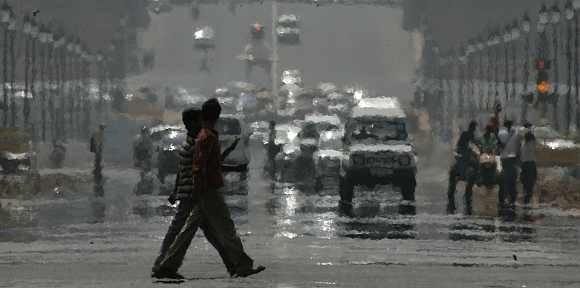
An intense heat wave that has driven daytime temperatures as high as 118°F (48°C) in parts of India has claimed over 500 lives and shows no signs of letting up soon. With climate change driving higher temperatures across the globe, scientists are warning to prepare for more such events in the future.
The hottest place in India was Allahabad, a city in the northern state of Uttar Pradesh, which saw mercury rise to 47.7 degrees Celsius (117.8 Fahrenheit) on Sunday, while the capital Delhi recorded a high of 43.5C (110.3F). Most of the 539 recorded deaths have been of construction workers, the elderly or the homeless in the southern states of Andhra Pradesh and Telangana, reports The BBC, but some deaths have also occurred in Uttar Pradesh, Odisha and West Bengal.
“Almost all the victims are old. Inquiries reveal that most of them were working and were exposed to the heat. Dehydration and heat stroke caused the deaths,” B.R. Meena, a senior Telangana state official, told the Indian Express newspaper.
The Indian Meteorological Department has issued a red warning to affected regions saying that the heat wave conditions are likely to continue over coming days. Meanwhile, authorities are urging people to take precautions, including staying indoors during the hottest part of the day (10am-4pm) and drinking plenty of fluids.
According to the Centers for Disease Control and Prevention, extreme temperatures are the deadliest of all weather-related phenomenon. From 1999 through 2009, extreme heat exposure caused or contributed to more than 7,800 deaths in the United States. Deaths generally result from heat stroke and related conditions, but also from cardiovascular disease, respiratory disease, and cerebrovascular disease. Heat waves are also associated with increased hospital admissions for cardiovascular, kidney, and respiratory disorders.
Extreme heat waves cause the most harm among elderly people and young children, as well as homeless people who have nowhere to go to escape the heat. City dwellers are at particular risk because of elevated temperatures in cities, known as the “urban heat island effect” due to the magnifying effect of paved surfaces and the lack of tree cover.
Average temperatures around the world have become significantly warmer since the start of the 20th century, and they have risen at a particularly fast rate during the last 50 years. The ten warmest years on record have all occurred since 2000, with 2014 ranking as the hottest year ever recorded. While a number of factors contribute to temperature patterns, overwhelming evidence points to man-made climate change as the driving force behind these warming trends. And as the effects of climate change persist, scientists say that the frequency and intensity of extreme heat events — and the health threats associated with them — will continue to rise.
“A [killer] heat wave … was a rare event in earlier times,” Dr. Michael Oppenheimer, professor of geosciences and international affairs at Princeton University, told Live Science. “It’s still a rare event, but much less so. In the future, it becomes a common event. It becomes the norm by the end of the century.”
From 1951 to 1980, extremely hot temperatures affected only one-tenth of one percent of the globe, before signs of global warming began turning up in the climate records. But in the last three decades, extreme heat events have become more widespread and now affect about 10 percent of the globe. In another decade, the number could rise to about 17 percent, according to a 2012 study led by James Hansen, the director of the NASA Goddard Institute for Space Studies.
“Our [study] makes clear that while average global temperature has been steadily rising due to a warming climate (up about 1.5 degrees Fahrenheit in the past century), the extremes are actually becoming much more frequent and more intense worldwide,” Hansen wrote in the Washington Post in 2012. The findings, he said, “revealed a stunning increase in the frequency of extremely hot summers, with deeply troubling ramifications for not only our future but also for our present.”
As average summer temperatures have risen over the past decade, the chances of even the most rare extreme heat events have grown dramatically, according to a 2014 study published in Nature Climate Change. Extremely warm summers that would have occurred twice a century in the early 2000s are now happening twice a decade, while thousand-year heat waves — like the one Europe experienced in 2003, which killed 70,000 people — are now occurring at a frequency of one in a 100 years and are projected to occur every other year by the 2030s to 2040s under continuing greenhouse gas emissions.
